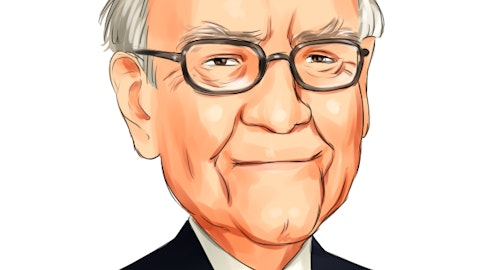Jeff Norris: Next question, please.
Operator: Our next question comes from the line of Moshe Orenbuch with TD Cowen. Your line is open.
Moshe Orenbuch: Great. Thanks. Maybe, Rich, just following up on that, I think that a lot of the marketing dollars in the card space have been spent, with the — at the transactor business. But given that, that’s — that stability that you’re talking about. And I assume the bulk of the dollars of loss, delinquency and loss are coming from kind of the lower end of the card spectrum. So does that mean that that’s an area for expansion in 2024, like, how should we think about that? And I do have a follow-up.
Richard Fairbank: Sorry, Moshe, are you saying, is what — is the lower-end an area for expansion?
Moshe Orenbuch: Yes.
Richard Fairbank: So, we feel — well, we feel good about all of our segments across the credit spectrum in card and also the relative health of the consumer. And you’ve known us for a long time, Moshe, as long as we have — for the decades we’ve been talking together, you know that we have a long history of delivering sustained resilience and profitability at the lower end of the marketplace. And we — let’s just reflect on this for a second. If you’re talking about subprime credit cards, this is a complex business that requires deep investment in information-based underwriting. And of course, we’ve spent decades developing and testing tailored product structures and sort of honing the analytical and the operating and underwriting and marketing capabilities to attract and serve this franchise, but also with the number one and two and three most important things to us has been resilient as we do this.
And what’s really been pretty striking is how consistent our strategy has been over the years, through the Great Recession and following that. And if we — and we’ve talked about how the lower-end of the marketplace, whether you’re talking, by the way, there’s a whole — when you talk about the lower end of the marketplace, obviously, we — there is a whole part of the marketplace that Capital One doesn’t serve. But in terms of the lower end of the marketplace that we serve, if you look at either income or FICO and look at the normalization that’s going on, we’ve seen very solid curing in that part of the market. It in fact even started — it cured a little bit earlier than some of the other parts of the market but the curing story, the leveling-off story we’re talking about today is absolutely across the board.
I do want to say though also, Moshe, relative to your point, you’ve had Fintechs who we were very concerned about flooding that end of the market. Some years ago, they certainly have massively dialed back. And I think that the continued — when we see the success of our vintages, the stabilization, now the sort of stabilization overall of Capital One’s whole portfolio and the dynamics in the marketplace, I think that we like the opportunities we see there, Moshe, and we will be leaning into that.
Moshe Orenbuch: Great. And just as a follow-up, I mean, you’ve talked in the past about not just the financial impact of the late fee, but also its deterrent impact. So how do you think about that in terms of the resilience of that segment as we go forward post any changes to late fees? And maybe just as a side point, you did mention that you thought you could maintain — improve the efficiency ratio even with the late fee. I mean, that just seems — that seems like a — like you’d have to take a couple $100 million out of expenses to do that. So if there is a way to talk about what — how that would happen, and tack that on to the answer, that would help too. Thanks.
Andrew Young: So, Moshe, Capital One has pursued a strategy for many years of trying to create and deliver to the marketplace, strikingly simple products. Because we, from sort of a mission and strategy point of view, we believe so much in this, but — and we’ve built a brand over having very simple products. And so things like, for example, on the banking side, no minimum balance requirements, no membership fees, and even no overdraft fees. So here we are a company that has really, really reduced the fees. But if we add one fee left, I think the fee we would most hang on to is the late fee. Because to your point, it plays a very important role in the deterrent value to a consumer. And an analogy that we sometimes use is a speeding ticket.
I think that if a speeding ticket were — let’s say, we had an $8 speeding ticket, I’m not sure that our highways would be quite as safe as they are now because if we’re really trying to deter behavior that we think is really consequential for people, that really is the role of the fee. We’ve been very active in giving alerts to all of our customers when the late payment due alerts, with the goal of trying to — not trying to maximize late fees, but actually trying to maximize the on-payment performance of our customers. So, Moshe, this is a question that — we’ve been worried about your question about the what could be the impact on credit performance of individuals and it’s something that we’re just going to have to. If this CFPB rule goes into effect, we’re all going to experience together sort of this — not controlled experiment, but we certainly mark us down for having a concern about that.
But from a financial point of view, obviously, the late fees are an important thing on the P&L. And as I’ve talked about, we have created, I’ve said it many actions across different types of things from policies, products, pricing structures, investment choices to claw back the very significant economic impact. Some of those things are underway. Some of them just to mention it, by the way. By the time we get there when the rule is announced, some of the offsets are going to by then be into the run rate of the company and the majority will still be waiting to happen. With respect to the fourth quarter, the [‘25] (ph) is the big full-year effect, obviously something coming in late in the fourth — it’s something coming in, in our estimate in the fourth quarter.





